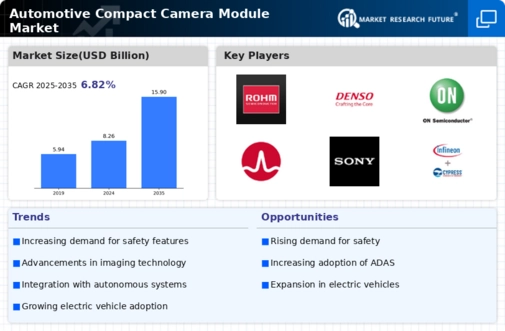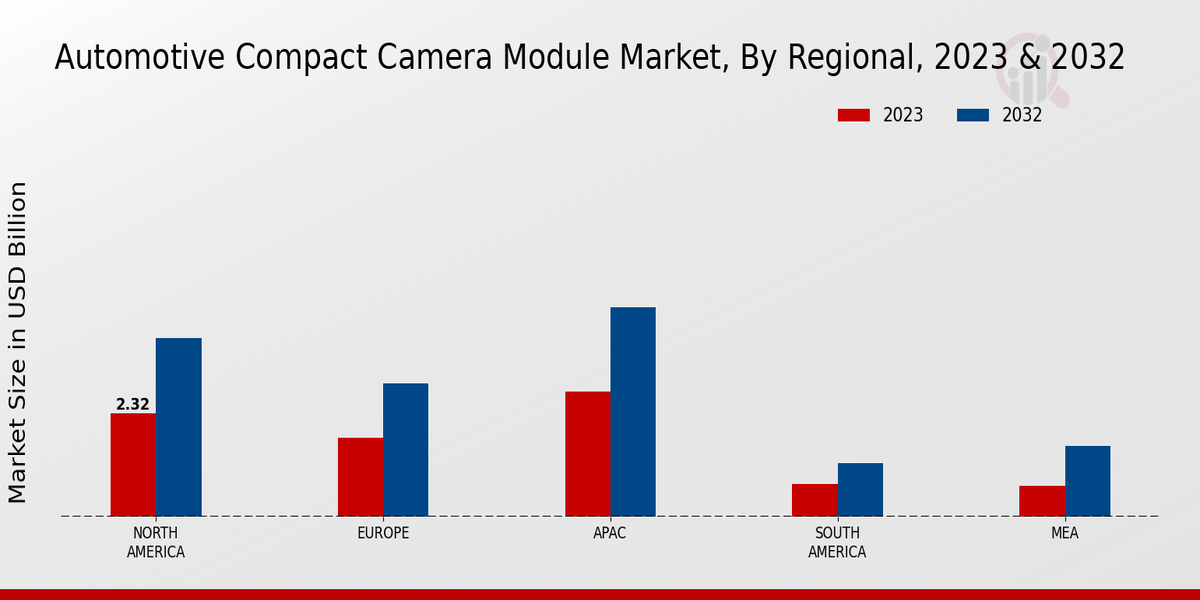Market Growth Projections
The Global Automotive Compact Camera Module Market Industry is projected to experience substantial growth in the coming years. With an anticipated market value of 8.26 USD Billion in 2024, the industry is set to expand significantly, driven by various factors such as technological advancements and increasing safety regulations. Furthermore, the market is expected to reach 15.9 USD Billion by 2035, reflecting a CAGR of 6.15% from 2025 to 2035. These figures indicate a robust trajectory for the industry, highlighting the potential for innovation and investment in compact camera technologies.
Regulatory Support for Safety Standards
Government regulations mandating safety standards in the automotive sector play a crucial role in shaping the Global Automotive Compact Camera Module Market Industry. Regulatory bodies worldwide are increasingly enforcing stringent safety requirements, which necessitate the incorporation of advanced camera systems in vehicles. This regulatory support not only drives demand for compact camera modules but also encourages manufacturers to innovate and enhance their offerings. As a result, the market is poised for growth, with an expected valuation of 8.26 USD Billion in 2024, reflecting the industry's responsiveness to regulatory changes.
Increasing Adoption of Electric Vehicles
The shift towards electric vehicles (EVs) presents a substantial opportunity for the Global Automotive Compact Camera Module Market Industry. As EV manufacturers seek to differentiate their products, the integration of advanced camera systems becomes essential for features like autonomous driving and enhanced safety. The growing number of EVs on the road is likely to drive demand for compact camera modules, contributing to the market's projected growth to 15.9 USD Billion by 2035. This trend indicates a broader acceptance of innovative technologies within the automotive sector, further solidifying the role of compact camera modules.
Rising Consumer Awareness and Preferences
Consumer awareness regarding vehicle safety and technology is on the rise, significantly impacting the Global Automotive Compact Camera Module Market Industry. As buyers become more informed about the benefits of advanced camera systems, their preferences increasingly lean towards vehicles equipped with such technologies. This shift in consumer behavior is likely to drive manufacturers to prioritize the integration of compact camera modules in their designs. Consequently, the market is projected to experience robust growth, with estimates suggesting a value of 15.9 USD Billion by 2035, underscoring the importance of aligning product offerings with consumer expectations.
Technological Advancements in Imaging Technology
Rapid advancements in imaging technology significantly influence the Global Automotive Compact Camera Module Market Industry. Innovations such as high-resolution sensors, improved low-light performance, and enhanced image processing capabilities are becoming standard in modern vehicles. These technological improvements not only enhance the functionality of compact camera modules but also expand their applications in areas like 360-degree views and night vision systems. As a result, the market is anticipated to grow at a CAGR of 6.15% from 2025 to 2035, reflecting the industry's adaptation to evolving consumer expectations and technological possibilities.
Growing Demand for Advanced Driver Assistance Systems
The increasing emphasis on safety features in vehicles drives the demand for advanced driver assistance systems (ADAS). The Global Automotive Compact Camera Module Market Industry benefits from this trend, as compact camera modules are integral to systems such as lane departure warnings and automatic emergency braking. As consumers prioritize safety, manufacturers are compelled to integrate these technologies, resulting in a projected market value of 8.26 USD Billion in 2024. This focus on safety is expected to enhance the adoption of compact camera modules, thereby contributing to the overall growth of the industry.





















Leave a Comment